Every spring my husband and I look forward to hiking in the mountains, often to an alpine lake for a little high-altitude fly-fishing. As a wildlife biologist I am always on the lookout for animals and spring is a great time to observe a variety of activity.
However, more often than not, I see wildlife sign – scat, tracks, and occasionally an evergreen (conifer) tree with the bark peeled off and laying on the ground or hanging in long ribbons in the branches.
When I see one of these curiously decorated trees, I inspect the trunk for vertical impressions that look suspiciously like teeth marks.
Wildlife CSI: Ruling Out the Usual Suspects
Trees are one of the many plant foods in nature’s lunchbox that provide nourishment for wildlife.
I often encounter trees with a particular kind of damage. These marks were made by something with teeth, that can climb, and is bigger than a breadbox.
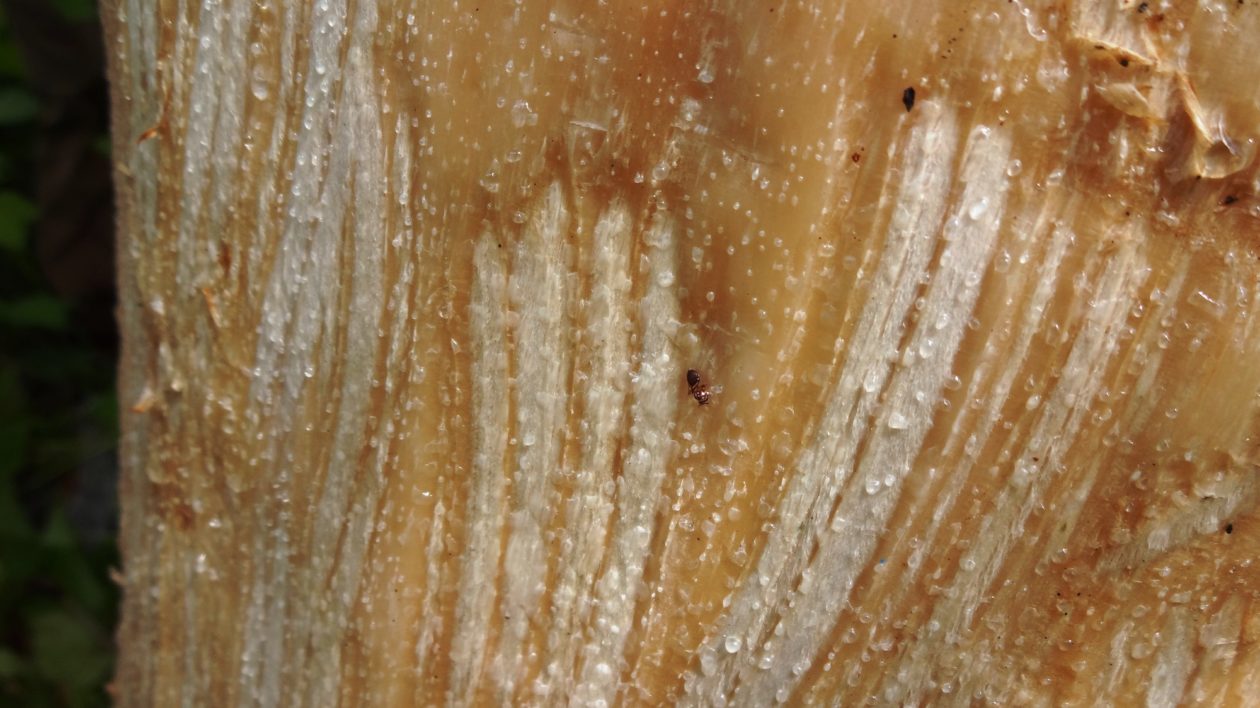
Voles (Microtus spp.) and mice (Peromyscus spp.) scrape the bark off seedlings and saplings during the winter, typically below the snow line. They burrow under the snow to the tree and start feeding on the bark. Considering the evidence mice and voles are not suspects.
Pocket gophers (Geomyidae, spp.) are subterranean specialists that prefer open areas with shorter vegetation and fewer woody plants. Big trees are not their jam.
I’ve had pocket gophers tunnel into my garden and pull my three-foot tall abundantly flowering tomato plants into their tunnel. Probably smiling all the way to their food storage cache. Tree seedlings can suffer the same demise. This suspect is excused.
Tree squirrels (Sciuridae family) remove bark, especially in winter and early spring, when food is scarce. Squirrels, in this case the pine squirrel, typically gnaw on horizontal branches and sometimes the trunk targeting the inner bark. Squirrels can strip bark from relatively large portions of a tree; however, this rodent is unlikely large enough to accomplish such significant tree damage.
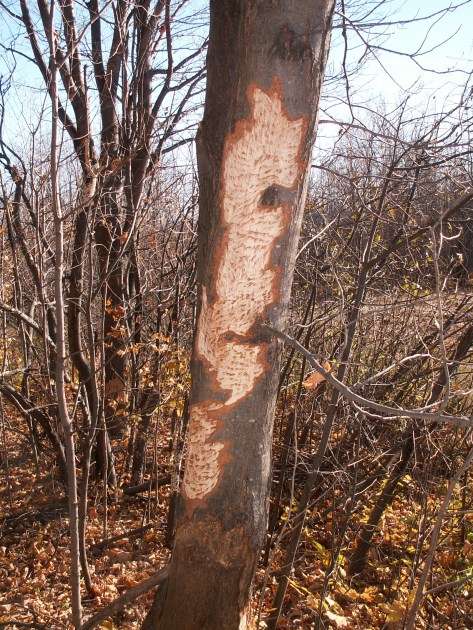
Snowshoe hares (Lepus americanus) favor smaller trees. Much to the frustration of many foresters, they will expertly work their way through a stand of freshly planted seedlings nipping off tops and some branches. They also chew on bark at the base of the tree, but in deep snow the damage occurs higher on the tree.
Deer (Odocoileus virginianus and hemionus) and elk (Cervus canadensis) are in the same category as snowshoe hare. They seem to have an internal radar for detecting newly planted seedlings. To these ungulates it is like finding candy scattered around an open section of ground. They can join the bunnies on the innocent list.
Moose (Alces alces) focus on hardwood (deciduous) saplings and smaller trees; although, they will eat the needles and branches of conifer trees when no deciduous plants (e.g., willow, pin cherry) are readily available. They do strip bark, but not on conifer trees and they can’t climb. Excused.
Woodpeckers (Dryocopus spp.) are unlikely offenders. They target trees teeming with insects like carpenter ants and beetle larva. Woodpeckers take advantage of this tasty food source by drilling into the tree to feast on the bugs. Woodpeckers don’t have teeth and the evidence clearly indicates something toothy.
A likely candidate is the porcupine (Erethizon dorsatum). Long claws on both front and back feet make them efficient climbers. They eat a variety of vegetation during the snow free months, but in the winter, they focus on needles and bark. They can shred an outhouse, so why not a large tree? About the size of a breadbox? Yes. Incisor impressions left on the tree? Yes. But wait, a porcupine scrapes in a crosshatched, horizontal pattern. Our subject tree has a vertical scrape pattern following the length of the truck and the teeth impressions are larger.
The guilty party that left these fine-looking incisor impressions was a bear, and although near my Idaho home it could be a grizzly, it is most likely a black bear.
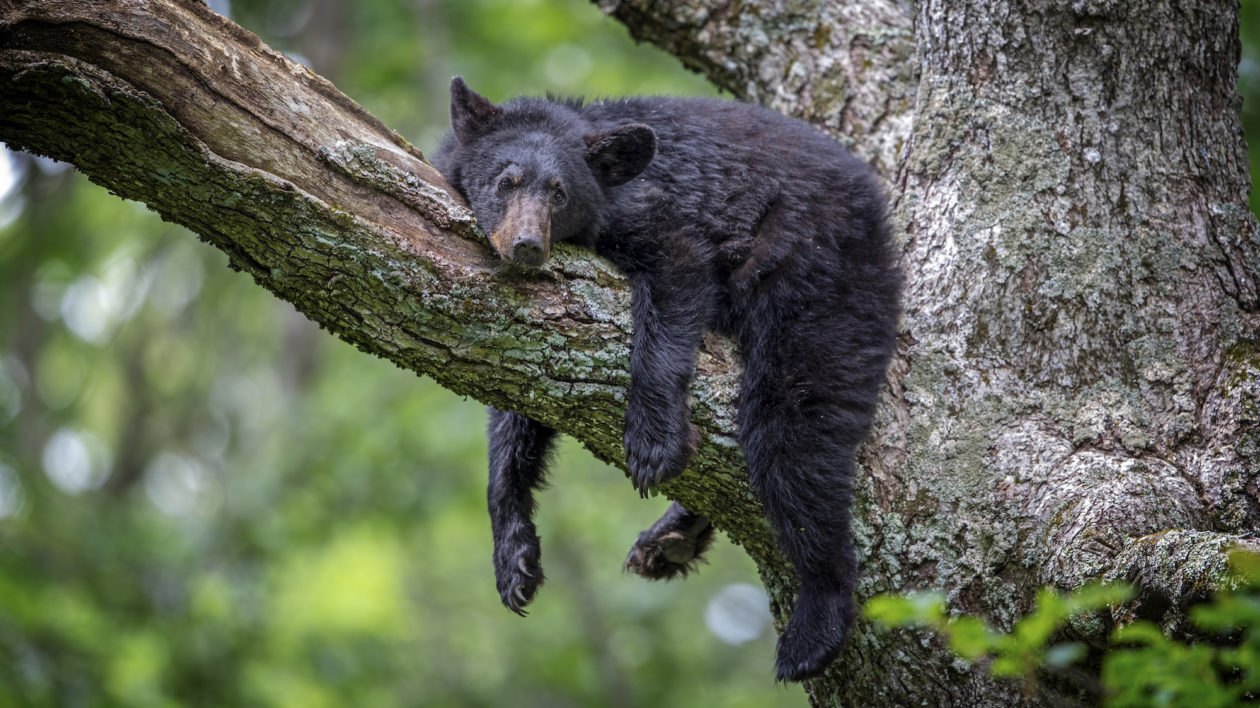
Bear Trees or Measuring Trees
Ernest Thompson Seton (1860-1946) was an author, wildlife artist, and early conservationist. His eight-volume set, The Lives of Game Animals (1909, 1926) discusses the natural history of many mammal species. I have the full eight-volume set and refer them regularly.
Seton references numerous studies, bulletins, and reports and I find these references interesting, and sometimes amusing.
In Volume II – Part I, there is a discussion about “Bear Trees or Measuring Trees.” Descriptions of bark-stripped trees are spot-on to what I’ve witnessed. However, the thoughts of the time were that this was a method of bear intercommunication or an annual height measuring stick.
According to a few references, a bear would stand on its hind legs and reach as high as possible to rip the bark. There was a question as to whether the same bear came every year or if another bear reached higher as if to say, “I’m bigger than you.”
Additionally, only “he-bears” would bite trees along their trails; the one that bites the highest is the one that owns the road.
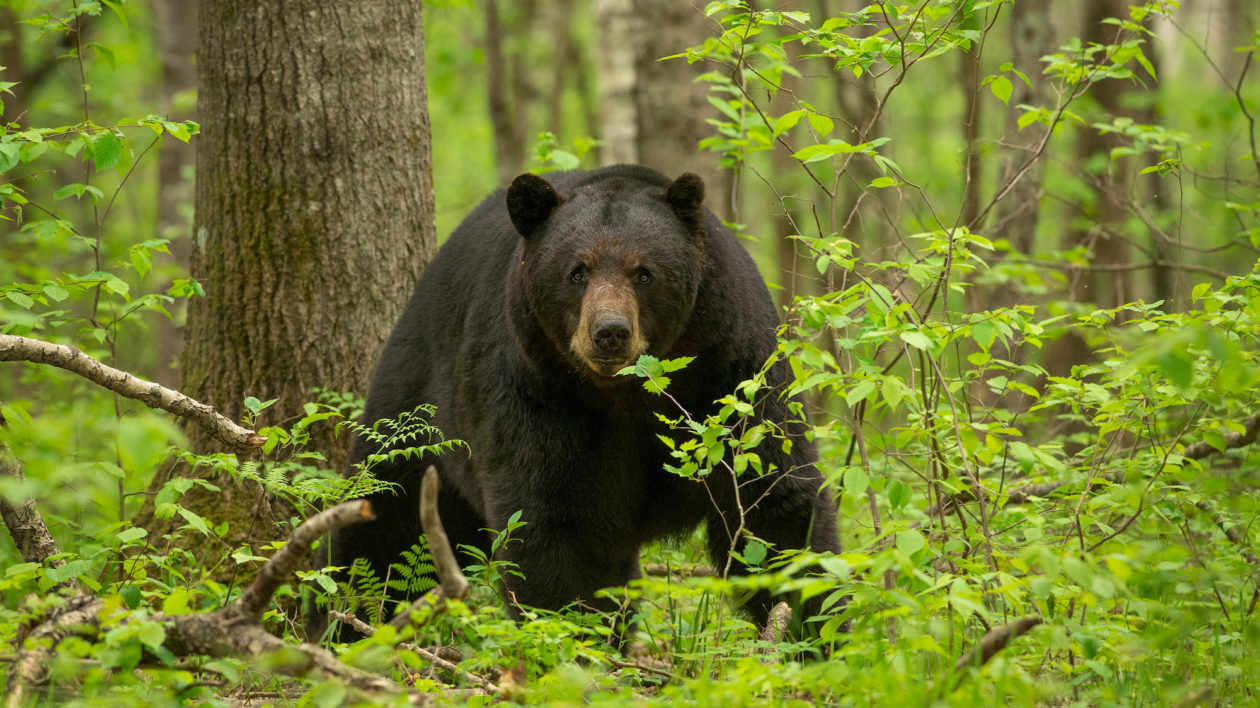
What Is Really Going On?
Bears are highly intelligent, incredibly strong, exceptionally curious, and, at times, entertaining. They are opportunistic omnivores and their intelligence, resourcefulness, and memory are especially evident when it comes to finding food.
They come out of their dens, shake off the fog of hibernation, and start looking for fuel. Food may be scarce so they often continue to lose weight as they feed off their remaining fat reserves. Any food that provides nourishment and energy is essential and trees are readily available.
Under the tree bark there is a thin layer of living cells known as the phloem, which carries nutrients to the cambium, another layer that produces bark cells on the exterior and wood cells in the interior of the tree.
As winter ebbs into spring, starch that has been stored in the tree roots is converted to sugar, and with the addition of water creates sap, which rises up through the cambium to nourish new growth. This is when the sap from maple trees is “tapped” to produce maple syrup.
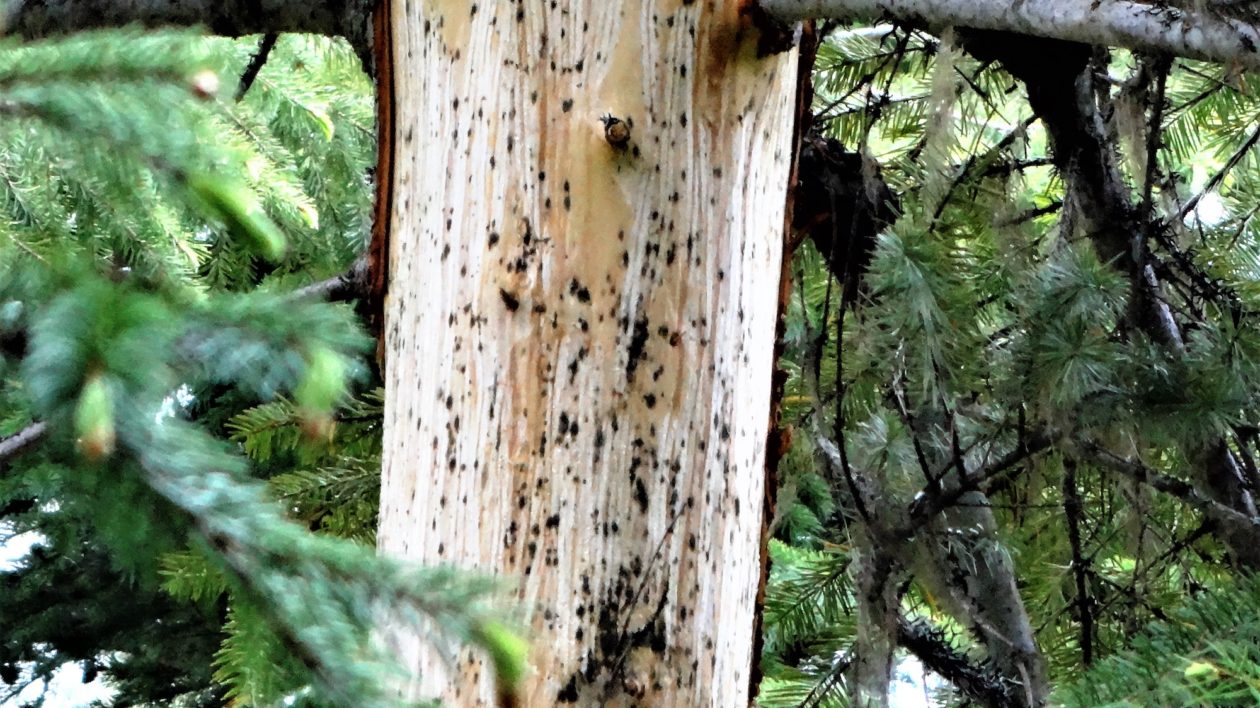
A Bit of History
In the 1940s, near Hoquiam, Washington, foresters noticed unusual damage at the base of trees in recently thinned stands. Long strips of bark lay on the ground around the tree, and vertical teeth marks ran the length of the debarked section.
The damage was more extensive than what a 12-to-35-pound porcupine could do. Foresters correctly suspected the damage was caused by black bears.
Damaged trees are typically 15 to 30 years old and 18 to 30 inches in diameter. Most of the time the damage is on the bottom 4 to 8 feet of the truck; however, trees can be peeled as high up as 30 feet.
The timber industry unwittingly created a springtime food source for bears by thinning timber stands. Thinning reduces intra-tree competition and provides additional moisture and nutrients to the remaining trees, which allows for more vigorous growth. A direct relationship between thinned timber stands and bear damage has been documented in several locations.
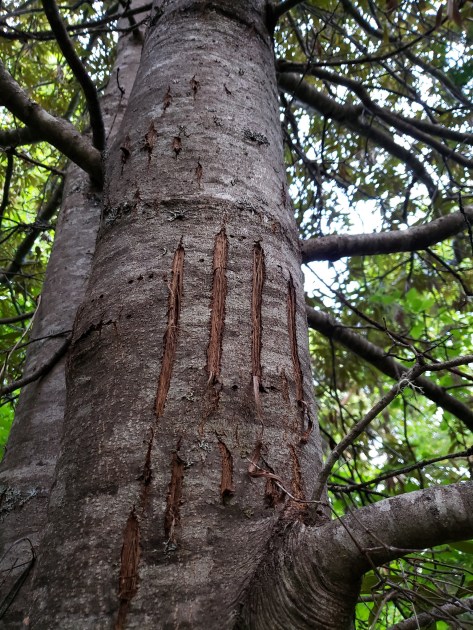
Bears are not particular about the trees they strip; damage to a variety of species has been documented. Bears tear the bark off using their teeth and short, curved claws, then scrape the sapwood off with their incisors.
In some instances, a tree will be completely girdled and killed. Bears will climb higher in the tree where the bark is thinner and peeling is easier. For smaller or younger bears this is an advantage.
Plants have a natural defense mechanism to minimize animal feeding – manufacturing chemical compounds called terpenes. When you walk through the forest, as you brush aside branches you often smell “pine.” You are smelling terpenes, the aromatic, highly volatile carbon compounds that create scent.
Several studies have shown that thinning timber stands increases the sugar concentration and tissue mass while terpene concentrations do not increase.
Bears prefer inner bark with strong concentrations of sugar and weak concentrations of terpenes, which may explain the preference for trees in thinned stands.
Bears may target managed timber stands, but I have seen stripped trees along hiking trails in random stands of timber. So, next time you are out enjoying the forest and you come across strips of bark at the base of a tree and obvious teeth marks on the tree trunk, keep an eye out: a bear could be nearby.




This is a good read. I live in Namibia, Africa, and I wish we had someone here who could go into that much detail about who the guilty tree scratchers are. I recently received a similar head-scratcher on a group that I am on. Let me know if you would be willing to take a stab, then I can send you some photos.
What an insightful read! It’s fascinating to learn about the various factors that can damage trees and how our perceptions might not always align with reality. Understanding the complexities of tree health is crucial for effective conservation efforts. At Eoroe, we provide the latest climate change news and insights, emphasizing the importance of maintaining our ecosystems, including our trees, in the fight against climate change. Thank you for sharing this valuable information!
Hi Ritch,
I would be happy to look at your photos, but I have a couple of questions.
How far up the trunk of the tree is the bark ripped off? Is it actually ripped off – do you see claw marks?
Often woodpeckers will flake the bark off of pine trees to get at insects underneath the bark.
An animal ripped bark either racing up or sliding down a pine tree in my yard (we sit on 5 acres with lots of small animals). I’m very curious as to what animal we have visiting. I’d like to email you pics and see what you think. Please reply and let me know if that is something you’d allow. Thanks. Ritch Workman. Melbourne, Florida
Interesting. Lived around bears and in woods a fair number of years and a couple of locations…but sure didn’t know this. Thanks.